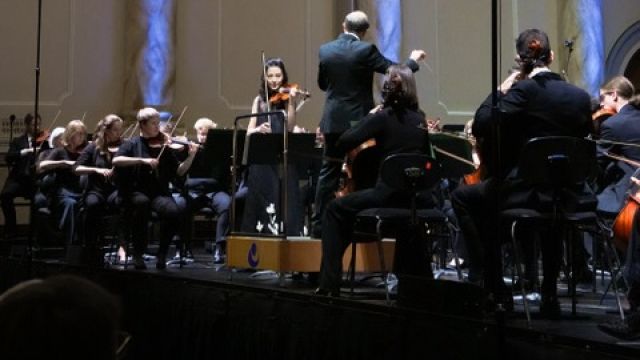Symphony Series 6 - Shadows
Recordings are wonderful, and an excellent way to expand your musical listening repertoire, but there is nothing to compare with being enveloped in sound that you can see, hear and feel!
The Adelaide Symphony Orchestra have clearly put a lot of thought into their latest concert, Symphony Series 6 - Shadows. From the soothing sounds of Peggy Glanville-Hicks, to the virtuosity of Britten’s Violin Concerto and the ferocity of the mighty Shostakovich 10, it is a memorable evening!
 Conducted by the fearless Mark Wigglesworth (who incidentally has recorded all fifteen of Shostakovich’s symphonies), the music is faultless. Wigglesworth throws himself into the task with incredible energy. He moves, sways, implores and most importantly interprets these three composers who are different in style, but kindred spirits.
Conducted by the fearless Mark Wigglesworth (who incidentally has recorded all fifteen of Shostakovich’s symphonies), the music is faultless. Wigglesworth throws himself into the task with incredible energy. He moves, sways, implores and most importantly interprets these three composers who are different in style, but kindred spirits.
In 1948, Peggy Glanville-Hicks composed the Three Gymnopédies for a small ensemble, drawing inspiration from ancient Greek culture, a theme similarly explored by Erik Satie in his works of the same name. She later orchestrated the intimate twelve-minute piece for orchestra.
Three Gymnopédies showcases Glanville-Hicks' ability to create emotive and atmospheric compositions, reflecting her rich experiences and creativity.
The first Gymnopedie Lento tranquillo features moody, haunting solo passages, soaring string passages and delicate harp passages. It uses modal scales and is almost archaic in style.
The second Gymnopodie Molto tranquillo, alla siesta begins with almost Celtic melodies in the violas and celeste (a welcome addition to her orchestration), and has the effect of taking us to another land.
The Third Gymnopedie Allegretto semplice is darker and more intense than the first two. There is a strong sense of pulse and a suggestion of Greek modal music.
Benjamin Britten wrote his Violin Concerto Op 15 in 1938-39 when he was still in his mid-twenties. He dedicated the concerto to Spanish violinist Antonio Brosa who premiered it in 1940. During this period Britten was in exile in the US at the outbreak of WW2, and there is a sense of political turbulence in sections of the piece.
South Korean/German Violinist Clara-Jumi Kang is the guest soloist. Internationally acclaimed, she is a master of her instrument, (She plays the “Thunis” Stradivarius violin from 1702) and throws herself into this technically fiendish concerto. Her playing soars above the orchestra and we can almost hear the violin ‘crying’ at times which is also reflected in her face.

The first movement Moderato con moto features a timpani solo creating an eerie opening with timpani strokes leading to a lyrical, searching theme on the violin. This builds into tempestuous, almost martial ending.
The second movement Vivace begins with a scherzo-like feel. It features virtuosic playing by Kang with some seriously technical work alternating with full orchestral passages in a sort of question-and-answer scenario.
The third movement Passacaglia : Andante lento (un poco meno mosso) is the heart of the concerto, built over a repeating bass line with heavy chords, sombre and noble. Little by little, the solo violin presents more virtuosic melodic lines and special effects, finally taking full spotlight supported by the French horns. Following a variation for full orchestra, the soloist re-joins, and the music’s texture and mood fades into uncertainty. (a premonition of the impending war?)
The evening concludes with Shostakovich’s Tenth Symphony in E Minor Op. 93., it is perhaps his greatest work, 57 minutes of tragedy, despair, terror, and violence and two minutes of triumph!
It was written in 1953, the same year Stalin died and is made up of four movements – Moderato, Allegro, Allegretto and Andante:Allegro.
The Symphony opens with an extended moderato that makes up nearly half of the work’s total length. The first movement revolves around two extended groups of thematic material. The first contrasts a steady throb that begins in the cellos and basses with longer notes held initially by violins and violas. Out of this, a melancholy theme emerges in the clarinet, from which Shostakovich builds to an impassioned, heart -wrenching climax.
The second movement is short, violent and stormy– it is a ‘race’ with heavy strong chords and the military drum making its presence felt. It is often interpreted as a musical portrait of Stalin.
In the third-movement waltz, the composer introduces his musical monogram derived from (DSCH) the German transliteration of his name, D. Schostakowitsch. At the movement’s close, the horn plays a motive based on a young pianist Shostakovich was fascinated with, Elmira Nazirova.

The last movement begins quietly, reminiscent of the earlier darkness and features a beautiful oboe solo, ending with a burst of energy in a thrilling climax.
This is a challenging piece for any orchestra both in its complexity and the stamina required to play as each section of the orchestra has its moment to shine. The Adelaide Symphony Orchestra did not only rise to the challenge they excelled, and earned well deserved lengthy applause.
The entire evening was a joy to experience and a tribute to the talent of the ASO, their conductor Mark Wigglesworth, and the amazing guest soloist Clara-Jumi Kang.
Shadows is a roller coaster ride of contentment, excitement and bliss. It is two hours of excellence from world class artists, bravo!
Barry Hill OAM
Subscribe to our E-Newsletter, buy our latest print edition or find a Performing Arts book at Book Nook.

